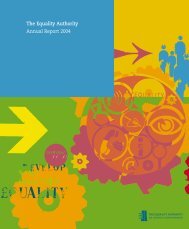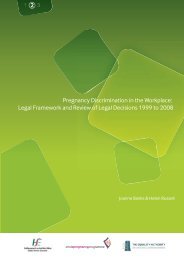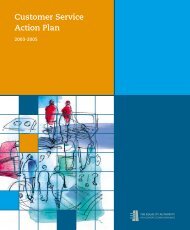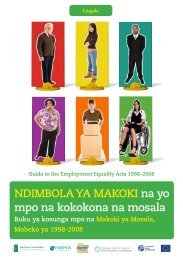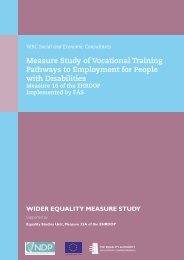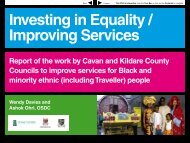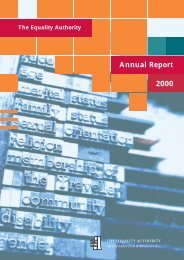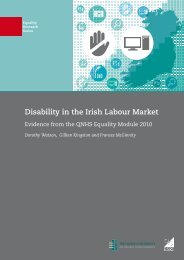Equality and Diversity - Building a Culture of ... - Equality Authority
Equality and Diversity - Building a Culture of ... - Equality Authority
Equality and Diversity - Building a Culture of ... - Equality Authority
You also want an ePaper? Increase the reach of your titles
YUMPU automatically turns print PDFs into web optimized ePapers that Google loves.
PHOTOCOPY this page<br />
Equal Respect<br />
Factsheet<br />
Stereotyping<br />
People with<br />
disabilities<br />
<strong>and</strong> their concerns are either invisible,<br />
marginalised, or depicted by negative<br />
stereotypes in the media. The world as<br />
represented on television fails to include<br />
them as a significant element in society.<br />
They may feature occasionally in news<br />
or magazine programmes but they rarely<br />
appear as regular characters in drama or<br />
other popular television forms.<br />
(National Disability <strong>Authority</strong>)<br />
Many Muslim women<br />
share the experience <strong>of</strong> facing an entire set<br />
<strong>of</strong> assumptions about their faith, politics,<br />
preferences, education, class, <strong>and</strong> so on,<br />
based on whether they choose to wear a<br />
headscarf or not. (Sahar Ullah, 2012)<br />
Whilst any ethnic group living in<br />
Irel<strong>and</strong> can experience racism, the<br />
evidence suggests that<br />
black people<br />
living in Irel<strong>and</strong> are most likely to<br />
experience racist discrimination,<br />
harassment <strong>and</strong> racially motivated<br />
crimes. (EU Agency for Fundamental<br />
Rights, 2009)<br />
Stereotypes about why people are<br />
homeless, the type <strong>of</strong> people who<br />
become homeless <strong>and</strong> assumptions<br />
about their behaviour can affect<br />
the services available to them. For<br />
example, the opening <strong>of</strong> a hostel for<br />
homeless people<br />
is opposed by other members <strong>of</strong> the<br />
community. (Department for Social<br />
Development N.I., 2009)<br />
Prejudice<br />
Numerous studies have shown that Irish<br />
<strong>and</strong> Northern Irish people do not want to<br />
live beside certain groups <strong>of</strong> people. In a<br />
survey <strong>of</strong> almost 5,000 Irish post-primary<br />
students, 42% said they would not be<br />
happy to have Travellers living near them.<br />
(Tormey <strong>and</strong> Gleeson, 2012)<br />
Education<br />
School text books have very<br />
little content which relates to<br />
minority ethnic groups, people<br />
with disabilities, or people<br />
from other minority groups.<br />
Over 20,000<br />
young people at second level are lesbian, gay or bisexual, <strong>and</strong> every<br />
class will therefore have an average <strong>of</strong> two students who are LGB.<br />
Yet this sizeable number is still largely invisible in any meaningful or<br />
positive way (NUI Maynooth <strong>and</strong> Gay Lesbian <strong>Equality</strong> Network, 2010)<br />
sECTION 3 EXPLORING <strong>Equality</strong> 71




